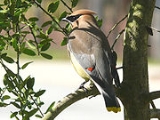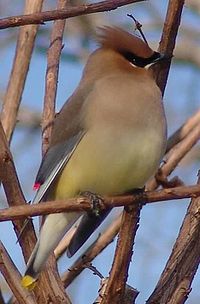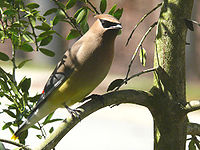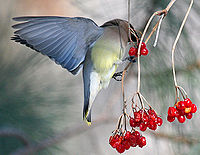
Cedar Waxwing
Encyclopedia
The Cedar Waxwing is a member of the family Bombycillidae
or waxwing family of passerine
birds. It breeds in open wooded areas in North America
, principally southern Canada
and the northern United States
.
(which breeds farther to the north and west).
These birds' most prominent feature is a small cluster of bright red feathers on the wings, a feature they share with the Bohemian Waxwing
(but not the Japanese Waxwing
). The tail is typically yellow or orange depending on diet. Birds that have fed on berries of introduced Eurasia
n honeysuckle
s while growing tail feathers will have darker orange-tipped tail-feathers. Adults have a pale yellow belly. Immature birds are streaked on the throat and flanks, and often do not have the black mask of the adults.
During courtship the male and female will sit together and pass small objects back and forth, such as flower petals or an insect. Mating pairs will sometimes rub their beaks together affectionately.
The flight of waxwings is strong and direct, and the movement of the flock in flight resembles that of a flock of small pale European Starling
s.
, with erratic winter movements, though most of the population migrates
farther south into the United States
and beyond, sometimes reaching as far as northern South America
. They will move in huge numbers if berry supplies are low. Rare vagrants have reached western Europe
, and there are two recorded occurrences of Cedar Waxwing sightings in Great Britain
. Individual Bohemian Waxwings will occasionally join large winter flocks of Cedar Waxwings.
In winter, these birds can be very confident and will come into garden
s for berry bushes and trees and to drink from fountains or bird baths.
Cedar waxwings fly at 25 miles per hour and fly at an altitude of 2000 ft.

and sugary fruit
year-round, with insect
s becoming an important part of the diet in the breeding season. Its fondness for the small cones of the Eastern Redcedar (a kind of juniper
) gave this bird its common name.
When the end of a twig holds a supply of berries that only one bird at a time can reach, members of a flock may line up along the twig and pass berries beak to beak down the line so that each bird gets a chance to eat.

During courtship, the pair may pass a flower petal or insect back and forth repeatedly. Usually 5 or 6 eggs are laid and the female incubates them for 12 to 16 days. The eggs are oval shaped with a smooth surface and very little, if any, gloss. The egg shells are of various shades of light or bluish grey with irregular, dark brown spots or greyish-brown splotches. Both parents build the nest and feed the young. Typically, there are two broods during the mating season. Young leave the nest about 14 to 18 days after hatching.
Cedar Waxwings are also known as the Southern Waxwing, Canada Robin, Cedar Bird, Cherry Bird, or Recellet.


, this species almost certainly inspired the waxwing mentioned prominently in his novel Pale Fire
.
Waxwings are evaluated as Least Concern by the IUCN Red List of Endangered Species.
Waxwing
The waxwings form the genus Bombycilla of passerine birds. According to most authorities, this is the only genus placed in the family Bombycillidae.-Description:Waxwings are characterised by soft silky plumage...
or waxwing family of passerine
Passerine
A passerine is a bird of the order Passeriformes, which includes more than half of all bird species. Sometimes known as perching birds or, less accurately, as songbirds, the passerines form one of the most diverse terrestrial vertebrate orders: with over 5,000 identified species, it has roughly...
birds. It breeds in open wooded areas in North America
North America
North America is a continent wholly within the Northern Hemisphere and almost wholly within the Western Hemisphere. It is also considered a northern subcontinent of the Americas...
, principally southern Canada
Canada
Canada is a North American country consisting of ten provinces and three territories. Located in the northern part of the continent, it extends from the Atlantic Ocean in the east to the Pacific Ocean in the west, and northward into the Arctic Ocean...
and the northern United States
Northern United States
Northern United States, also sometimes the North, may refer to:* A particular grouping of states or regions of the United States of America. The United States Census Bureau divides some of the northernmost United States into the Midwest Region and the Northeast Region...
.
Description
Cedar waxwings are approximately 6 - long and weigh roughly 30 grams. They are smaller and more brown than their close relative, the Bohemian WaxwingBohemian Waxwing
The Bohemian Waxwing is a member of the waxwing family of passerines. A sleek bird, 18–21 cm long with a pointed crest, it travels in large, nomadic groups with a strong, direct flight. It breeds in coniferous forests throughout the most northern parts of Europe, Asia and western North America...
(which breeds farther to the north and west).
These birds' most prominent feature is a small cluster of bright red feathers on the wings, a feature they share with the Bohemian Waxwing
Bohemian Waxwing
The Bohemian Waxwing is a member of the waxwing family of passerines. A sleek bird, 18–21 cm long with a pointed crest, it travels in large, nomadic groups with a strong, direct flight. It breeds in coniferous forests throughout the most northern parts of Europe, Asia and western North America...
(but not the Japanese Waxwing
Japanese Waxwing
The Japanese Waxwing is a fairly small passerine bird of the waxwing family found in north-east Asia. It feeds mainly on fruit and berries but also eats insects during the summer. The nest is a cup of twigs lined with grass and moss which is built in a tree.-Description:The Japanese Waxwing is...
). The tail is typically yellow or orange depending on diet. Birds that have fed on berries of introduced Eurasia
Eurasia
Eurasia is a continent or supercontinent comprising the traditional continents of Europe and Asia ; covering about 52,990,000 km2 or about 10.6% of the Earth's surface located primarily in the eastern and northern hemispheres...
n honeysuckle
Honeysuckle
Honeysuckles are arching shrubs or twining vines in the family Caprifoliaceae, native to the Northern Hemisphere. There are about 180 species of honeysuckle, 100 of which occur in China; Europe, India and North America have only about 20 native species each...
s while growing tail feathers will have darker orange-tipped tail-feathers. Adults have a pale yellow belly. Immature birds are streaked on the throat and flanks, and often do not have the black mask of the adults.
During courtship the male and female will sit together and pass small objects back and forth, such as flower petals or an insect. Mating pairs will sometimes rub their beaks together affectionately.
The flight of waxwings is strong and direct, and the movement of the flock in flight resembles that of a flock of small pale European Starling
European Starling
The Common Starling , also known as the European Starling or just Starling, is a passerine bird in the family Sturnidae.This species of starling is native to most of temperate Europe and western Asia...
s.
Vocalizations
The calls of these birds include very high-pitched whistles and buzzy trills often represented as see or sree.Seasonal movements
Outside the breeding season, Cedar Waxwings often feed in large flocks numbering hundreds of birds. This species is irruptiveIrruptive growth
Irruptive growth, sometimes called Malthusian growth, is a growth pattern defined by population explosions and subsequent sharp population crashes, or diebacks...
, with erratic winter movements, though most of the population migrates
Bird migration
Bird migration is the regular seasonal journey undertaken by many species of birds. Bird movements include those made in response to changes in food availability, habitat or weather. Sometimes, journeys are not termed "true migration" because they are irregular or in only one direction...
farther south into the United States
United States
The United States of America is a federal constitutional republic comprising fifty states and a federal district...
and beyond, sometimes reaching as far as northern South America
South America
South America is a continent situated in the Western Hemisphere, mostly in the Southern Hemisphere, with a relatively small portion in the Northern Hemisphere. The continent is also considered a subcontinent of the Americas. It is bordered on the west by the Pacific Ocean and on the north and east...
. They will move in huge numbers if berry supplies are low. Rare vagrants have reached western Europe
Western Europe
Western Europe is a loose term for the collection of countries in the western most region of the European continents, though this definition is context-dependent and carries cultural and political connotations. One definition describes Western Europe as a geographic entity—the region lying in the...
, and there are two recorded occurrences of Cedar Waxwing sightings in Great Britain
Great Britain
Great Britain or Britain is an island situated to the northwest of Continental Europe. It is the ninth largest island in the world, and the largest European island, as well as the largest of the British Isles...
. Individual Bohemian Waxwings will occasionally join large winter flocks of Cedar Waxwings.
In winter, these birds can be very confident and will come into garden
Garden
A garden is a planned space, usually outdoors, set aside for the display, cultivation, and enjoyment of plants and other forms of nature. The garden can incorporate both natural and man-made materials. The most common form today is known as a residential garden, but the term garden has...
s for berry bushes and trees and to drink from fountains or bird baths.
Cedar waxwings fly at 25 miles per hour and fly at an altitude of 2000 ft.

Diet
The Cedar Waxwing eats berriesBerry
The botanical definition of a berry is a fleshy fruit produced from a single ovary. Grapes are an example. The berry is the most common type of fleshy fruit in which the entire ovary wall ripens into an edible pericarp. They may have one or more carpels with a thin covering and fleshy interiors....
and sugary fruit
Fruit
In broad terms, a fruit is a structure of a plant that contains its seeds.The term has different meanings dependent on context. In non-technical usage, such as food preparation, fruit normally means the fleshy seed-associated structures of certain plants that are sweet and edible in the raw state,...
year-round, with insect
Insect
Insects are a class of living creatures within the arthropods that have a chitinous exoskeleton, a three-part body , three pairs of jointed legs, compound eyes, and two antennae...
s becoming an important part of the diet in the breeding season. Its fondness for the small cones of the Eastern Redcedar (a kind of juniper
Juniper
Junipers are coniferous plants in the genus Juniperus of the cypress family Cupressaceae. Depending on taxonomic viewpoint, there are between 50-67 species of juniper, widely distributed throughout the northern hemisphere, from the Arctic, south to tropical Africa in the Old World, and to the...
) gave this bird its common name.
When the end of a twig holds a supply of berries that only one bird at a time can reach, members of a flock may line up along the twig and pass berries beak to beak down the line so that each bird gets a chance to eat.
Habitat
Preferred habitat consists of trees at the edge of wooded areas, or "open" forests, especially those that provide access to berry sources as well as water. Waxwings are attracted to the sound of running water, and love to bathe in and drink from shallow creeks. In urban or suburban environments, waxwings often favor parkland with well-spaced trees; golf courses, cemeteries, or other landscaping with well-spaced trees; bushes that provide berries; and a nearby water source such as a fountain or birdbath.
Nesting
The nest is a loose open cup built with grass and twigs, lined with softer materials and supported by a tree branch averaging 2 to 6 meters above ground but, at times, considerably higher. The outer diameter of the nest is approximately 12 cm to 16 cm.During courtship, the pair may pass a flower petal or insect back and forth repeatedly. Usually 5 or 6 eggs are laid and the female incubates them for 12 to 16 days. The eggs are oval shaped with a smooth surface and very little, if any, gloss. The egg shells are of various shades of light or bluish grey with irregular, dark brown spots or greyish-brown splotches. Both parents build the nest and feed the young. Typically, there are two broods during the mating season. Young leave the nest about 14 to 18 days after hatching.
Cedar Waxwings are also known as the Southern Waxwing, Canada Robin, Cedar Bird, Cherry Bird, or Recellet.


Cedar Waxwings in literature and law
According to experts on the writing of Vladimir NabokovVladimir Nabokov
Vladimir Vladimirovich Nabokov was a multilingual Russian novelist and short story writer. Nabokov wrote his first nine novels in Russian, then rose to international prominence as a master English prose stylist...
, this species almost certainly inspired the waxwing mentioned prominently in his novel Pale Fire
Pale Fire
Pale Fire is a novel by Vladimir Nabokov. The novel is presented as a 999-line poem titled "Pale Fire", written by the fictional John Shade, with a foreword and lengthy commentary by a neighbor and academic colleague of the poet. Together these elements form a narrative in which both authors are...
.
Waxwings are evaluated as Least Concern by the IUCN Red List of Endangered Species.
External links
- United States Geological Survey general info on cedar waxwings
- USGS summer (breeding) map for cedar waxwings
- USGS winter distribution map for cedar waxwings
- General info, including photos and videos, with specific sites for finding cedar waxwings in San Diego County, California
- South Dakota Birds - Cedar Waxwing Information and Photos
- Stamps
- Cedar Waxwing videos on the Internet Bird Collection
- Cedar Waxwings photos from South Carolina

